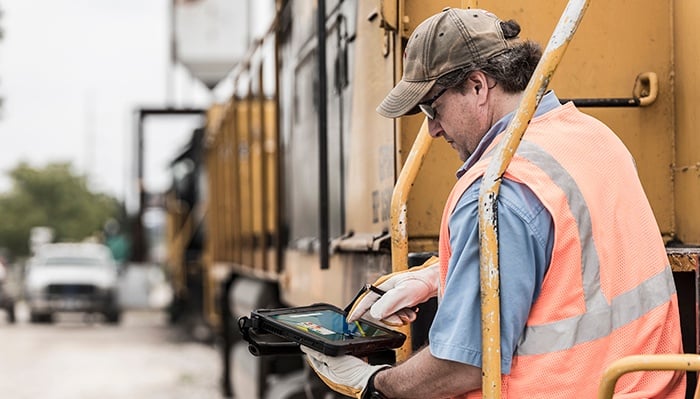What is Service Chain Optimisation?
Jan 19, 2018 • Features • Paul Whitelam • ClickSoftware • supply chain • Parts Pricing and Logistics
Paul Whitelam, VP of Product Marketing, ClickSoftware explains why service chain optimisation needn’t be as daunting as we might expect...
Every customer-centric business is ultimately measured by how it performs on the day of service delivery. But the day of service is just the last link in the chain of decisions made weeks or months in advance. And sometimes your best-laid plans don’t play out as expected. Disruptions in the schedule are bound to happen – customers cancel, traffic conditions vary, and technicians call out sick.
So how can you possibly ensure your techs are at the right places at the right time, while increasing productivity, delivering positive customer experiences, and keeping costs down—even when managing the unexpected?
For one, you must consider the entire service chain, or everything that occurs before, on, and after the day of service. Let’s dive deeper into what this means.
Service Chain Optimisation(SCO)
The modern-day customer has more power than ever before. With companies like Amazon and Uber setting the bar for customer experience, customers today demand and expect reliable, flexible, and almost flawless service. And that’s not impossible to deliver.
In 1996, ClickSoftware coined the term “Service Chain Optimisation”(SCO) to define a decision making process for ensuring an efficient day of service. It considers the full life-cycle of service demand, from the early stages of forecasting and planning, through scheduling and dispatching, to execution and analysis. And it’s meant to help you find the optimal balance between business goals and customer expectations.
It’s important to understand that all the steps in SCO are interrelated, and that missing steps means service delivery could sufferIt’s important to understand that all the steps in SCO are interrelated, and that missing steps means service delivery could suffer. Let’s say a dispatcher jumps right into scheduling without any forecasting or planning. They might schedule too many technicians, which is expensive and creates excessive idle time. Or they could schedule too few techs, which would mean slower response times and frustrated customers. Likewise, without proper planning, a tech might find that he or she is without the right parts to complete a job – again, leaving the customer upset.
It’s not hard to understand why it’s important to consider all links in the service chain. Let’s break it down into the three major stages:
The Day Before: Planning
Ultimately the goal of SCO is to ensure your technicians are at the right place at the right time, fully prepared to meet customer demand. But as the service day is full of unpredictability and variation, success is derived from what happens in the planning stage.
This stage involves predicting to the best of your ability the expected demand on a particular day or week. And it’s where you determine the optimal amount of resources you’ll need to complete every service call, without over or underestimating. Historical data (or anything gathered from the analysis stage) can help you make the right decisions.
The Day of: Execution
The day of service is where everything happens – from scheduling and dispatch, to fixing the customer’s problem and following up with a survey. Though a schedule may have been created days or weeks in advance, not all appointments will be honoured. There will likely be customer cancellations, traffic delays, or emergency jobs, which will require real-time management.
As noted, the success of this day depends on the planning ahead. You may not know exactly what’s going to happen on the day of service, but you better be prepared for anything that comes at you. This stage relies heavily on maximsing your time and responding effectively to changes. So it helps to have a flexible schedule to reshuffle as new jobs appear.
The Day After: Analysis
We all know that service doesn’t end after the execution. In the final stage of the service chain, field service providers must look back on how the day went and whether goals were met. And if they weren’t, what is it that kept them from achieving their goals? How did customers feel about the job done?
We all know that service doesn’t end after the execution. Because you can’t improve what you don’t measure, track your performance and use customer feedback to continually improve quality. Although it’s called the service chain, it might be more accurate to think of it as a continuous cycle, where you feed the results of your analysis back to the forecasting and planning for subsequent visits.
Use artificial intelligence to your advantage
You might be wondering how a mere human can possibly optimise every step in the chain, make accurate predictions, and quickly reshuffle the schedule when something comes up. Fortunately, with the power of artificial intelligence (AI) and machine learning, you can automatically optimise schedules and make accurate predictions in seconds.
Here’s an example: with a mobile workforce it’s important to reduce idle time and keep technicians moving so they can complete more jobs and make as many customers happy as possible. AI-driven technology can take into account both historical and real-time traffic data to quickly choose the best travel routes to customer sites. By avoiding traffic, techs can complete the job faster and move on to the next.
Or consider when there are schedule disruptions. Instead of leaving white space when a customer cancels, the AI-driven technology can account for technician locations and automatically dispatch them to another nearby job. Likewise, to make room for emergency jobs, the system can take SLA requirements into consideration and reshuffle low priority tasks to make room.
Service Chain Optimisation might seem complicated, but with the right technology, proper planning, and analysis, it’s possible to deliver near flawless service to your customers.
Be social and share





















 Field Service News is published by 1927 Media Ltd, an independent publisher whose sole focus is on the field service sector. As such our entire resources are focused on helping drive the field service sector forwards and aiming to best serve our industry through honest, incisive and innovative media coverage of the global field service sector.
Field Service News is published by 1927 Media Ltd, an independent publisher whose sole focus is on the field service sector. As such our entire resources are focused on helping drive the field service sector forwards and aiming to best serve our industry through honest, incisive and innovative media coverage of the global field service sector.
Leave a Reply